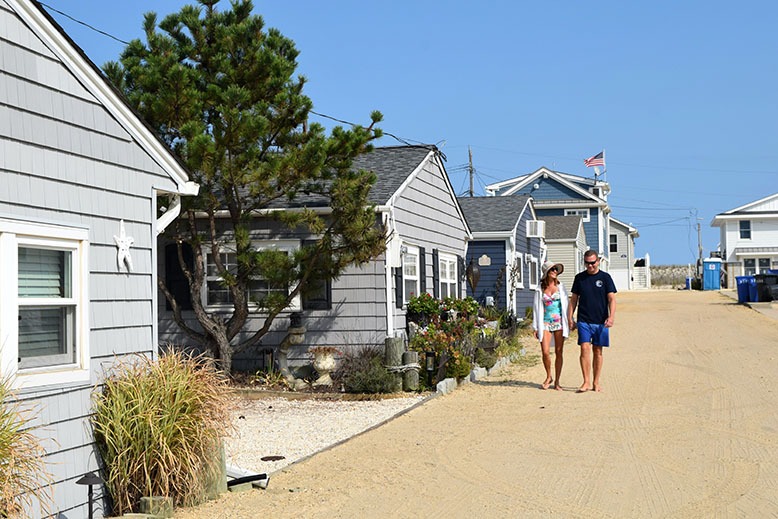
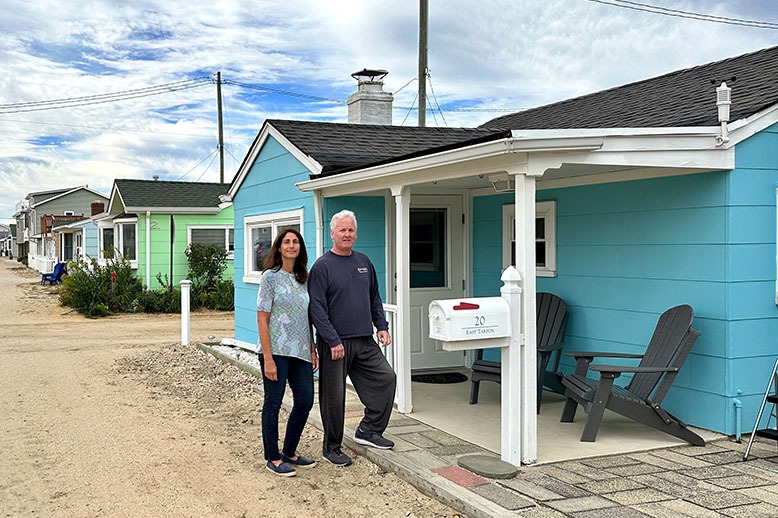 Robert and Marie Chrone’s 480-square-foot summer cottage is a refuge. Arriving in town, Marie says, “transforms you.” Photo: R.C. Staab[/caption]
Like many homeowners, the Chrones rent out their cottage on a weekly basis during the prime summer season, carving out two weeks for themselves. Nowadays, most of the homes are upgraded with heat and air conditioning, better siding, and new windows—critical for rentals. Families with one or two children happily pay $2,500–$3,000 a week for a vacation spot within steps of the beach. The Chrones’ rental enables them to cover most of the cost of their mortgage, insurance payments and property tax.
With home prices on most lots from $625,000 to $650,00, it’s debatable whether these homes are in reach for the average working person. But considering the run-up of property prices along the ocean in Monmouth and Ocean counties, the cottages—with their in-demand rental income—are considered a bargain for first-time buyers at the Shore looking for something other than a condo.
Fred and Ed’s clever business strategy included selling some homes outright for the capital, but selling other homes while keeping a long-term lease on the land, eventually creating an annuity for their families. One-third of the homes in OBIII still sit on leased land. It’s a dilemma for some buyers, knowing they have to pay homeowners association fees, property taxes and about $10,000 a year for the lease. Marie says, “Leased land was a foreign concept to us. Why would someone buy a house on it? We couldn’t bring ourselves to do it.” But homes on leased land sell for about $150,000 less than those on owned land, making them attractive to entry-level buyers.
Along busy Route 35, drivers can blink and never notice they’ve passed through OBIII and its 11 neighboring communities, including Ocean Beach I and Ocean Beach II, none of which are contiguous. Sandwiched between Brick Township Beaches and Lavallette, this tiny seaside section of Toms Rivers Township is variously known as Shore North, Shore North Beaches, Dover Beaches North or Lavallette, if one asks the post office for the mailing address.
[caption id="attachment_309798" align="alignnone" width="778"]
Robert and Marie Chrone’s 480-square-foot summer cottage is a refuge. Arriving in town, Marie says, “transforms you.” Photo: R.C. Staab[/caption]
Like many homeowners, the Chrones rent out their cottage on a weekly basis during the prime summer season, carving out two weeks for themselves. Nowadays, most of the homes are upgraded with heat and air conditioning, better siding, and new windows—critical for rentals. Families with one or two children happily pay $2,500–$3,000 a week for a vacation spot within steps of the beach. The Chrones’ rental enables them to cover most of the cost of their mortgage, insurance payments and property tax.
With home prices on most lots from $625,000 to $650,00, it’s debatable whether these homes are in reach for the average working person. But considering the run-up of property prices along the ocean in Monmouth and Ocean counties, the cottages—with their in-demand rental income—are considered a bargain for first-time buyers at the Shore looking for something other than a condo.
Fred and Ed’s clever business strategy included selling some homes outright for the capital, but selling other homes while keeping a long-term lease on the land, eventually creating an annuity for their families. One-third of the homes in OBIII still sit on leased land. It’s a dilemma for some buyers, knowing they have to pay homeowners association fees, property taxes and about $10,000 a year for the lease. Marie says, “Leased land was a foreign concept to us. Why would someone buy a house on it? We couldn’t bring ourselves to do it.” But homes on leased land sell for about $150,000 less than those on owned land, making them attractive to entry-level buyers.
Along busy Route 35, drivers can blink and never notice they’ve passed through OBIII and its 11 neighboring communities, including Ocean Beach I and Ocean Beach II, none of which are contiguous. Sandwiched between Brick Township Beaches and Lavallette, this tiny seaside section of Toms Rivers Township is variously known as Shore North, Shore North Beaches, Dover Beaches North or Lavallette, if one asks the post office for the mailing address.
[caption id="attachment_309798" align="alignnone" width="778"]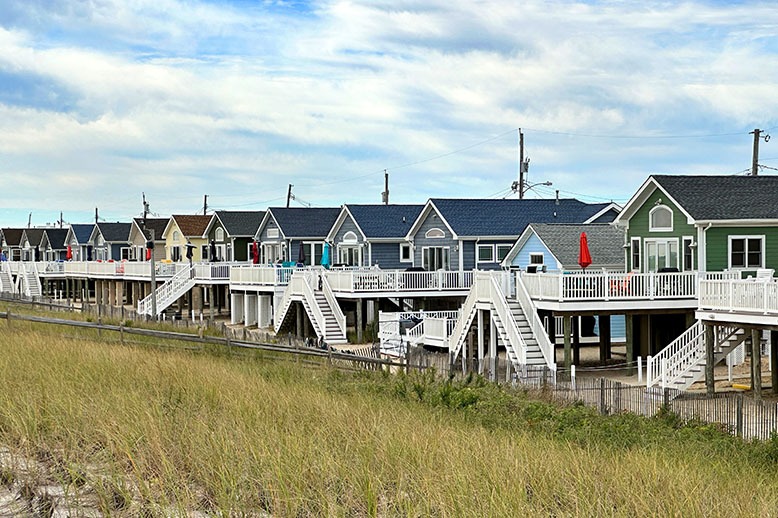 Ocean Beach III may be the densest area of single-family homes anywhere on the Jersey Shore. Photo: R.C. Staab[/caption]
Each community has a homeowners association (or club, as the locals say) with separate dues, rules, beach badges and lifeguards. Most clubs have a bayside playground or community space for movie nights, barbecues, kids’ activities and more.
OBIII is different for one reason: the streets. It’s not the fact that the streets are mostly named for birds or marine life. As Kevin Iredell, who lives in Cranford and owns a vacation home on Albacore Way with his wife, Lisa, says, “Ocean Beach III is unique because it only has sandy streets.” The sandy streets have what Lisa describes as a good vibe. “This to me is as beachy as it gets,” she says.
It’s a good vibe unless you have a dog. Pets are not permitted on the paths and roads. As resident Bridget Chirchirillo describes it, “You have to have to carry them up to [Route] 35 or drive them up.”
The look of the roads contributes to another factor that people frequently mention as a key selling point. Paul and Bridget Chirchirillo had previously owned a Shore home in Bradley Beach, sold it, moved to Wall Township and started looking for another beach spot during the pandemic. They found it on Dolphin Way. Paul says, “This place appealed to us because of the sand roads and the traditional way of life. The more we spoke to people, they would say, ‘My grandmother owned a house. I grew up here. My kids grew up here. All my grandchildren—70 years of tradition.’”
Ocean Beach III may be the densest area of single-family homes anywhere on the Jersey Shore. Photo: R.C. Staab[/caption]
Each community has a homeowners association (or club, as the locals say) with separate dues, rules, beach badges and lifeguards. Most clubs have a bayside playground or community space for movie nights, barbecues, kids’ activities and more.
OBIII is different for one reason: the streets. It’s not the fact that the streets are mostly named for birds or marine life. As Kevin Iredell, who lives in Cranford and owns a vacation home on Albacore Way with his wife, Lisa, says, “Ocean Beach III is unique because it only has sandy streets.” The sandy streets have what Lisa describes as a good vibe. “This to me is as beachy as it gets,” she says.
It’s a good vibe unless you have a dog. Pets are not permitted on the paths and roads. As resident Bridget Chirchirillo describes it, “You have to have to carry them up to [Route] 35 or drive them up.”
The look of the roads contributes to another factor that people frequently mention as a key selling point. Paul and Bridget Chirchirillo had previously owned a Shore home in Bradley Beach, sold it, moved to Wall Township and started looking for another beach spot during the pandemic. They found it on Dolphin Way. Paul says, “This place appealed to us because of the sand roads and the traditional way of life. The more we spoke to people, they would say, ‘My grandmother owned a house. I grew up here. My kids grew up here. All my grandchildren—70 years of tradition.’”
[RELATED: The Pandemic Fueled These Incredible Home Renovation Projects]
Paul says when his grandchildren saw the house, “they lost their minds, they were so happy. They ran up to the dunes and the beach and saw it. The next day, they asked when they were going to come back.” Perhaps the quaintest of the communities, OBIII today most closely resembles Ed and Fred’s original vision. “There are deed restrictions,” adds Kevin Iredell. “You can’t go up. You can’t put an addition on. You basically have to leave it the way it is. That keeps that old-school, 1950s kind of Jersey Shore feel.” There are no McMansions and no five-bedroom houses for partygoers like those infamously featured on MTV’s Jersey Shore in nearby Seaside Heights. People who buy and rent in OBIII know what they are getting, choosing the family-oriented, quiet lifestyle, away from the boardwalks and clubs. [caption id="attachment_309797" align="alignnone" width="778"]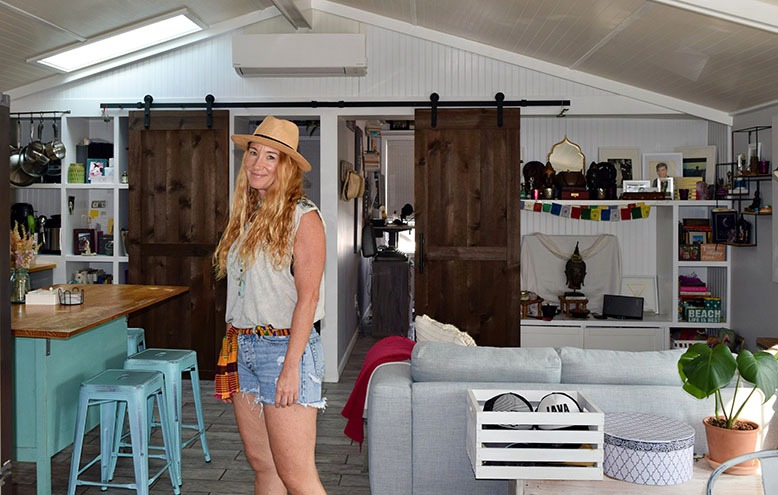 Ashley Swartz is among the handful of OBIII residents who live there year-round. Photo: R.C. Staab[/caption]
“It’s as if Dirty Dancing was filmed by the sea instead of a lake,” says full-time resident Ashley Swartz. When she first bought her house in 2015 while still living in New York City, she says “it felt like what I would imagine the Jersey Shore to be like in the 1950s, like time had stood still, with sand streets, these little cottages, and with children playing in the street, riding their bikes freely.”
Of course, a 500-square-foot house creates challenges, including having only one bathroom, which is typically only 40 square feet. In homes like the Chirchirillos’ that hark back to the 1940s, the bathroom is accessed by two doors—one from the kitchen and one from outside.
“It was designed for people to have their kids come right in from the beach into the potty and not have to go into the house,” Bridget says. They generally lock the outside bathroom door, but when Paul is barbecuing on the outdoor patio, everyone is warned he’ll be cutting through the bathroom to get to the kitchen.
The two bedrooms are the same size, barely big enough for a queen-size bed. Owners often add bunk beds in the second bedroom and a pull-out couch in the living room to attract renters. The Chirchirillos have told prospective renters their home sleeps six or seven people.
Storage space is severely limited as well. As Kevin Iredell describes it, “Everything we have has to have a place. We don’t bring any extra.”
[caption id="attachment_309796" align="alignnone" width="778"]
Ashley Swartz is among the handful of OBIII residents who live there year-round. Photo: R.C. Staab[/caption]
“It’s as if Dirty Dancing was filmed by the sea instead of a lake,” says full-time resident Ashley Swartz. When she first bought her house in 2015 while still living in New York City, she says “it felt like what I would imagine the Jersey Shore to be like in the 1950s, like time had stood still, with sand streets, these little cottages, and with children playing in the street, riding their bikes freely.”
Of course, a 500-square-foot house creates challenges, including having only one bathroom, which is typically only 40 square feet. In homes like the Chirchirillos’ that hark back to the 1940s, the bathroom is accessed by two doors—one from the kitchen and one from outside.
“It was designed for people to have their kids come right in from the beach into the potty and not have to go into the house,” Bridget says. They generally lock the outside bathroom door, but when Paul is barbecuing on the outdoor patio, everyone is warned he’ll be cutting through the bathroom to get to the kitchen.
The two bedrooms are the same size, barely big enough for a queen-size bed. Owners often add bunk beds in the second bedroom and a pull-out couch in the living room to attract renters. The Chirchirillos have told prospective renters their home sleeps six or seven people.
Storage space is severely limited as well. As Kevin Iredell describes it, “Everything we have has to have a place. We don’t bring any extra.”
[caption id="attachment_309796" align="alignnone" width="778"]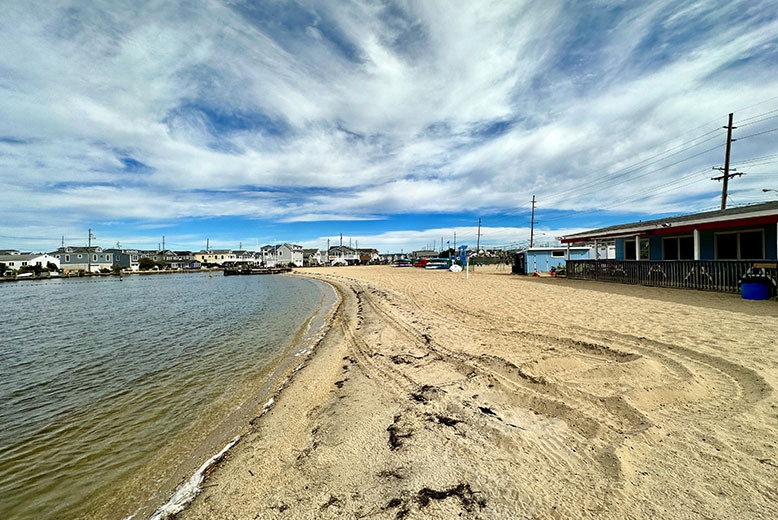 Almost 1,000 tiny homes comprise the Ocean Beach III community. Photo: R.C. Staab[/caption]
Some homeowners, like the Chrones, haven’t been able to figure out how to add a washer and dryer without redoing the house completely. While space is tight inside, as Marie says, “a lot of the house is outdoor living. Almost everyone has a patio with chairs, a table and some outdoor grill.”
At first glance, the houses seem nearly on top of each other. But as John McDonough, local Realtor and one of Fred Pearl’s grandsons, says, “These are small lots on small streets. [Fred and Ed] didn’t want big houses, tall houses, to create almost a tenement affect, which you have up in the big cities of North Jersey. Most everything is in a checkerboard pattern the way the houses are laid out, so it maximizes the space between each house. You can’t be closer than 10 feet to the rear lot line. You’ve got to be 20 feet minimum away from your neighbor. So there’s always at least 20 feet from all these little houses. You don’t feel like you’re cramped, like someone is right there.”
Sure enough, despite many homeowners renting to new tenants each week throughout the summer, there’s very little complaining about rowdy behavior and noise. “We’re not a community that rents out to kids for parties,” Bridget Chirchirillo says. “People care.” Paul adds, “They respect it. It’s traditional. They want to maintain that 1950s, 1960s, maybe 1940s feel. Everybody goes to the ice cream store at night and waits to get their cone.”
Aptly, the ice cream store is a Dairy Queen.
While the vast majority of owners are families with children or retirees with kids and grandkids who come down in short stints, there are a few full-time residents. Swartz managed to buy one of the larger homes—all 729 square feet—on Osprey Way. She eventually moved to OBIII full time in 2017.
As a single professional woman without children who worked in Manhattan, Swartz says, “I could not have more different life experience than my neighbors, and sometimes that extends to politics. I have learned, which happens naturally when living in such small spaces, that despite this, we often have the same values.”
She adds, “I have beautiful neighbors; we are a family and a community, and they would and have done anything for me. I’m better at listening to hear and to better understand. Living here has made me a better person.”
For Swartz and the handful of others who live there year-round, there is one drawback: “The island becomes a ghost town as of the end of October, with street lights blinking.”
R.C. Staab writes extensively about the Jersey Shore, including the book 100 Things to Do at the Jersey Shore. In the summer, he runs, swims, kayaks and walks the beaches from Sandy Hook to Cape May.
Almost 1,000 tiny homes comprise the Ocean Beach III community. Photo: R.C. Staab[/caption]
Some homeowners, like the Chrones, haven’t been able to figure out how to add a washer and dryer without redoing the house completely. While space is tight inside, as Marie says, “a lot of the house is outdoor living. Almost everyone has a patio with chairs, a table and some outdoor grill.”
At first glance, the houses seem nearly on top of each other. But as John McDonough, local Realtor and one of Fred Pearl’s grandsons, says, “These are small lots on small streets. [Fred and Ed] didn’t want big houses, tall houses, to create almost a tenement affect, which you have up in the big cities of North Jersey. Most everything is in a checkerboard pattern the way the houses are laid out, so it maximizes the space between each house. You can’t be closer than 10 feet to the rear lot line. You’ve got to be 20 feet minimum away from your neighbor. So there’s always at least 20 feet from all these little houses. You don’t feel like you’re cramped, like someone is right there.”
Sure enough, despite many homeowners renting to new tenants each week throughout the summer, there’s very little complaining about rowdy behavior and noise. “We’re not a community that rents out to kids for parties,” Bridget Chirchirillo says. “People care.” Paul adds, “They respect it. It’s traditional. They want to maintain that 1950s, 1960s, maybe 1940s feel. Everybody goes to the ice cream store at night and waits to get their cone.”
Aptly, the ice cream store is a Dairy Queen.
While the vast majority of owners are families with children or retirees with kids and grandkids who come down in short stints, there are a few full-time residents. Swartz managed to buy one of the larger homes—all 729 square feet—on Osprey Way. She eventually moved to OBIII full time in 2017.
As a single professional woman without children who worked in Manhattan, Swartz says, “I could not have more different life experience than my neighbors, and sometimes that extends to politics. I have learned, which happens naturally when living in such small spaces, that despite this, we often have the same values.”
She adds, “I have beautiful neighbors; we are a family and a community, and they would and have done anything for me. I’m better at listening to hear and to better understand. Living here has made me a better person.”
For Swartz and the handful of others who live there year-round, there is one drawback: “The island becomes a ghost town as of the end of October, with street lights blinking.”
R.C. Staab writes extensively about the Jersey Shore, including the book 100 Things to Do at the Jersey Shore. In the summer, he runs, swims, kayaks and walks the beaches from Sandy Hook to Cape May.
No one knows New Jersey like we do. Sign up for one of our free newsletters here. Want a print magazine mailed to you? Purchase an issue from our online store.
The post Inside the Jersey Shore’s Unique Community of Tiny Houses appeared first on New Jersey Monthly.
